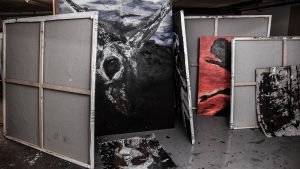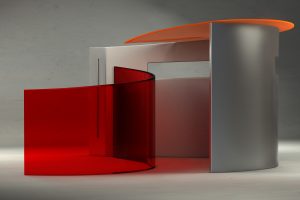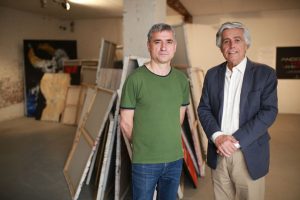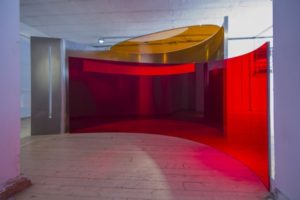
Inners Landscapes
2015 – 56th Edition
SPIAZZI, CASTELLO
The title chosen for this edition by the curator of the 56th International Art Exhibition, Okwui Enwezor, was All the World’s Futures.
The government of Andorra selected two artists to represent Andorra at the 2015 Biennal : Agustí Roqué, sculptor, and Joan Xandri, painter.
To speak of landscape, both in general and in this particular case, means to speak especially of ideological implications: the necessity of identifying a country from the linguistic, scientific, historic, literary and æsthetic points of view.
To speak of (interior) landscape(s) today does not mean to speak only of a piece of territory; it is rather a space to travel in, a space of happenings, the place where Roqué and Joan Xandri leave the imprints of their æsthetic and ethical sensibilities, the reflection of their relationship with the world.
It’s an interior landscape, a subjective one, one that may also be a space for reflection, for re-questioning—with the artists’ eyes as our starting point—our world and our received beliefs.


BEHIND THE WIND OF INNER LANDSCAPES
According to Lyotard, “the work of art carries within it an excess, an overflow, a potential for associations that goes beyond all prior determinations of its reception and its production.”
In selecting Roqué and Joan Xandri, the first, elementary consideration was how to begin to speak with them about their work. It’s an emotional thing. If you know someone whose work you find attractive, how do you go about asking for an interview? It’s frightening, because you know there are several possible responses.
The proposition we are making to you with Inner Landscapes is, precisely, a voyage of initiation along the routes of the memories of Roqué and Xandri, where all of the landscapes seen and lived blend and merge, as we discover their previous aspects, while they, the artists, recreate them in new forms and with new essences. Into ideal landscapes? Perhaps … you will find in the selection of these artists, a constant tension materialized in the oppositions and juxtapositions of individual works.
(From the beginning, my aim has been to give a thoughtful vision of contemporary art in Andorra, without however forgetting the references to the past. I wished to show the public what the differences are between the two artists, in terms both of form and of sensitivity.)
The two artists have reflected on the project for quite some time; it has of course modulated and been modified during that time. These plausible allusions to the passage of time and to the construction of a personal geography in which we can see ourselves reflected and can identify ourselves, even in the most insignificant and everyday things, are the elements that ultimately seduced me in the elaboration of this project.
The thing I would emphasize finally is the need to offer “authentic moments”, truthful situations, realities that transform themselves before our eyes.
Joana Baygual / Sebastià Petit / Francesc Rodríguez
Deputy Commissioners
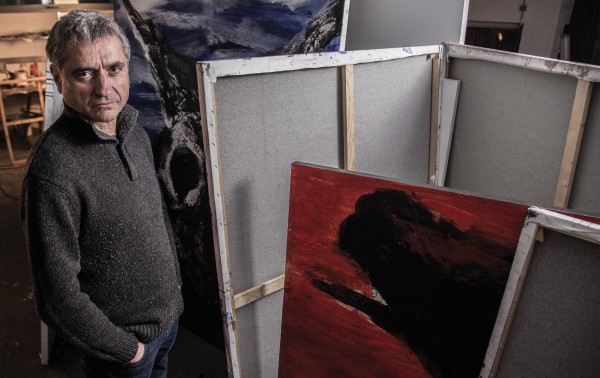
Joan Xandri – SHARED SOULD
It is impossible for an artist to remain insensitive to the ecosystem of the Principality of Andorra. In this mountainous territory of extraordinary beauty, nestled in the chain of the Pyrenees between France and Spain, nature, omnipresent, rubs shoulders with an imposing urban scene of shops and commerce of all kinds, judged by many to be bordering on kitsch. But the mountains are very close and the inhabitants can feel, on those snowy summits, near the sky and infinity, in a sort of subliminal euphoria.
The young Joan Xandri grew up in this exceptional environment. The complex relationship, both physical and emotional, that mankind has with his fellow man and with nature forms the basis of reflection for my work.
Agustí Roqué – INSIDE INSIDE
In the twentieth century, the language of modernity intruded into the world of sculpture. It is one of the salient facts in the evolution of the history of art. In the last century, the priorities and preoccupations in sculpture have changed radically, from the research for formal perfection to the assimilation of new materials, then to the mastery of space itself, and finally today to the quite natural utilisation of the most contemporary and up-to-date tools. There is no doubt that the visage of sculpture has changed radically. Statuary has completely disappeared, giving place to the emergence to a new dimension, that of the work of art in space.
Agustí Roqué boasts a long artistic career initiated in the seventies and is considered to be one of the most outstanding representatives of the great tradition of Catalan iron sculpture. After living in London for ten years, his work has combined a certain British sculptural tradition with a strong urban consciousness.






